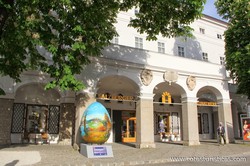




Housed in the Neuen Residenz (to which it moved in 2005), the Salzburg Museum is the museum of artistic and cultural history for the city and region of Salzburg. It originated as the Provincialmuseum and was also previously known as the Museum Carolino-Augusteum.
The Salzburg Museum was founded in 1834 when a small collection of military memorabilia was made accessible to the public to formalise the memories of the Napoleonic wars. When the widow of Austrian Emperor Franz Joseph I moved to Salzburg she became the trustee of the collection. After the revolution in 1848 the collection became the official town museum of Salzburg.
In 1923 the natural history objects of the museum were given to the Haus de Natur. One year later the folk culture collection opened a side-branch in the Monatsschlössl in the parks of Hellbrunn Palace.
During WWII, the museum got three direct hits from bombs. Most of the collection had already been taken into mines that served as bunkers; however, the building was completely destroyed alongside with many very large objects that had been immobile. Several objects disappeared from their bunkers during the time of US occupation - including a collection of gold coins that was kept in the salt mines of Hallein. A new building was opened as a provisory museum in 1967. A debate about a final and worthy headquarter of the Salzburg Museum started and lasted for decades. Side-branches of the Salzburg Museum were opened during this time: The Domgrabungsmuseum in 1974, the Spielzeugmuseum (Toy Museum) in 1978 and a newly developed Festungsmuseum (Fortress Museum) in 2000. By 1997, local politicians had finally agreed on assigning the Neue Residenz as a new venue for the Salzburg Museum.
he museum reopened in the Neue Residenz in 2005. In 2009 the museum received the European Museum of the Year Award.
The Salzburg Museum was founded in 1834 when a small collection of military memorabilia was made accessible to the public to formalise the memories of the Napoleonic wars. When the widow of Austrian Emperor Franz Joseph I moved to Salzburg she became the trustee of the collection. After the revolution in 1848 the collection became the official town museum of Salzburg.
In 1923 the natural history objects of the museum were given to the Haus de Natur. One year later the folk culture collection opened a side-branch in the Monatsschlössl in the parks of Hellbrunn Palace.
During WWII, the museum got three direct hits from bombs. Most of the collection had already been taken into mines that served as bunkers; however, the building was completely destroyed alongside with many very large objects that had been immobile. Several objects disappeared from their bunkers during the time of US occupation - including a collection of gold coins that was kept in the salt mines of Hallein. A new building was opened as a provisory museum in 1967. A debate about a final and worthy headquarter of the Salzburg Museum started and lasted for decades. Side-branches of the Salzburg Museum were opened during this time: The Domgrabungsmuseum in 1974, the Spielzeugmuseum (Toy Museum) in 1978 and a newly developed Festungsmuseum (Fortress Museum) in 2000. By 1997, local politicians had finally agreed on assigning the Neue Residenz as a new venue for the Salzburg Museum.
he museum reopened in the Neue Residenz in 2005. In 2009 the museum received the European Museum of the Year Award.
| Compartido por: Cristina Nascimento | Aún no hay comentarios |
| Vistas: 6067 | |
Comparta los lugares de interés para visitar, los lugares que visitó en sus vacaciones o los lugares en su ciudad natal que desea promocionar.
Coordenadas GPS
Lat : 47.798454 - Lon : 13.048085
N47° 47' 54.4344 " E13° 2' 53.106"
Comentarios
Aún no hay comentarios para
Museo de Salzburgo
Se conoces Museo de Salzburgo Deja su comentario
Museo de Salzburgo
Se conoces Museo de Salzburgo Deja su comentario
GRACIAS

